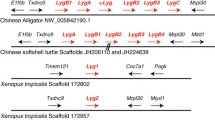Abstract
The proteasome subunit beta type-8 (PSMB8) gene encodes a catalytic subunit of the immunoproteasome, which is involved in the generation of peptides presented by MHC class I molecules. To date, highly diverged dichotomous alleles of PSMB8 have been reported in Oryzias species (actinopterygian teleosts) and Xenopus species (sarcopterygian amphibians). These dimorphic alleles share a similar substitution (A/V31F/Y) at the 31st position of the mature protein, which is most probably involved in formation of the S1 pocket. This substitution likely confers different cleavage specificities on the dimorphic PSMB8s. In addition, two paralogous PSMB8 genes possessing the A and F residues at the 31st position have been reported in sharks. Phylogenetic analysis indicated that the two types of PSMB8 of Oryzias, Xenopus, and sharks arose by independent evolutionary events. Here, we identified another pair of dimorphic alleles of PSMB8, which have the A and F residues at the 31st position of the mature protein, from bichir, Polypterus senegalus, a basal actinopterygian. The sequences of the mature proteins-encoding region of the dimorphic alleles of bichir PSMB8, the A and F types, showed only 72.7% and 77.5% identities at the nucleotide and the deduced amino acid levels, respectively. Their intronic sequences show almost no similarity, indicating that the dimorphic alleles of bichir PSMB8 have a very ancient origin. However, phylogenetic analysis showed that the dimorphisms of PSMB8 of bichir, Xenopus, and Oryzias arose by independent evolutionary events, suggesting the presence of a strong selective pressure for possessing the dimorphism.




Similar content being viewed by others
References
Agarwal AK, Xing C, DeMartino GN, Mizrachi D, Hernandez MD, Sousa AB, Martínez de Villarreal L, dos Santos HG, Garg A (2010) PSMB8 encoding the β 5i proteasome subunit is mutated in joint contractures, muscle atrophy, microcytic anemia, and panniculitis-induced lipodystrophy syndrome. Am J Hum Genet 87:866–872
Akiyama K, Yokota K, Kagawa S, Shimbara N, Tamura T, Akioka H, Nothwang HG, Noda C, Tanaka K, Ichihara A (1994) cDNA cloning and interferon gamma down-regulation of proteasomal subunits X and Y. Science 265:1231–1234
Edgar RC (2004) MUSCLE: multiple sequence alignment with high accuracy and high throughput. Nucleic Acids Res 32:1792–1797
Fehling HJ, Swat W, Laplace C, Kühn R, Rajewsky K, Müller U, von Boehmer H (1994) MHC class I expression in mice lacking the proteasome subunit LMP-7. Science 265:1234–1237
Felsenstein J (1985) Confidence limits on phylogenies: an approach using the bootstrap. Evolution 39:783–791
Frazer KA, Pachter L, Poliakov A, Rubin EM, Dubchak I (2004) VISTA: computational tools for comparative genomics. Nucleic Acids Res 32:W273–W279
Früh K, Gossen M, Wang K, Bujard H, Peterson PA, Yang Y (1994) Displacement of housekeeping proteasome subunits by MHC-encoded LMPs: a newly discovered mechanism for modulating the multicatalytic proteinase complex. EMBO J 13:3236–3244
Groll M, Ditzel L, Löwe J, Stock D, Bochtler M, Bartunik HD, Huber R (1997) Structure of 20S proteasome from yeast at 2.4 A resolution. Nature 386:463–471
Jones DT, Taylor WR, Thornton JM (1992) The rapid generation of mutation data matrices from protein sequences. Comput Appl Biosci 8:275–282
Kandil E, Namikawa C, Nonaka M, Greenberg AS, Flajnik MF, Ishibashi T, Kasahara M (1996) Isolation of low molecular mass polypeptide complementary DNA clones from primitive vertebrates. Implications for the origin of MHC class I-restricted antigen presentation. J Immunol 156:4245–4253
Kasahara M (1997) New insights into the genomic organization and origin of the major histocompatibility complex: role of chromosomal (genome) duplication in the emergence of the adaptive immune system. Hereditas 127:59–65
Miura F, Tsukamoto K, Mehta RB, Naruse K, Magtoon W, Nonaka M (2010) Transspecies dimorphic allelic lineages of the proteasome subunit beta-type 8 gene (PSMB8) in the teleost genus Oryzias. Proc Natl Acad Sci USA 107:21599–21604
Namikawa C, Salter-Cid L, Flajnik MF, Kato Y, Nonaka M, Sasaki M (1995) Isolation of Xenopus LMP-7 homologues. Striking allelic diversity and linkage to MHC. J Immunol 155:1964–1971
Nei M, Kumar S (2000) Molecular evolution and phylogenetics. Oxford University Press, New York
Nonaka M, Yamada-Namikawa C, Flajnik MF, Du Pasquier L (2000) Trans-species polymorphism of the major histocompatibility complex-encoded proteasome subunit LMP7 in an amphibian genus, Xenopus. Immunogenetics 51:186–192
Ohta Y, McKinney EC, Criscitiello MF, Flajnik MF (2002) Proteasome, transporter associated with antigen processing, and class I genes in the nurse shark Ginglymostoma cirratum: evidence for a stable class I region and MHC haplotype lineages. J Immunol 168:771–781
Saitou N, Nei M (1987) The neighbor-joining method: a new method for reconstructing phylogenetic trees. Mol Biol Evol 4:406–425
Sansom I, Smith M, Smith M (1996) Scales of thelodont and shark-like fishes from the Ordovician of Colorado. Nature 379:628–630
Tamura K, Peterson D, Peterson N, Stecher G, Nei M, Kumar S (2011) MEGA5: molecular evolutionary genetics analysis using maximum likelihood, evolutionary distance, and maximum parsimony methods. Mol Biol Evol 28:2731–2739
Tanaka K, Kasahara M (1998) The MHC class I ligand-generating system: roles of immunoproteasomes and the interferon-gamma-inducible proteasome activator PA28. Immunol Rev 163:161–176
Tsukamoto K, Hayashi S, Matsuo MY, Nonaka MI, Kondo M, Shima A, Asakawa S, Shimizu N, Nonaka M (2005) Unprecedented intraspecific diversity of the MHC class I region of a teleost medaka, Oryzias latipes. Immunogenetics 57:420–431
Unno M, Mizushima T, Morimoto Y, Tomisugi Y, Tanaka K, Yasuoka N, Tsukihara T (2002) The structure of the mammalian 20S proteasome at 2.75 A resolution. Structure 10:609–618
Author information
Authors and Affiliations
Corresponding author
Electronic supplementary material
Below is the link to the electronic supplementary material.
Esm. 1
(PDF 145 kb)
Rights and permissions
About this article
Cite this article
Fujito, N.T., Nonaka, M. Highly divergent dimorphic alleles of the proteasome subunit beta type-8 (PSMB8) gene of the bichir Polypterus senegalus: implication for evolution of the PSMB8 gene of jawed vertebrates. Immunogenetics 64, 447–453 (2012). https://doi.org/10.1007/s00251-012-0602-8
Received:
Accepted:
Published:
Issue Date:
DOI: https://doi.org/10.1007/s00251-012-0602-8




